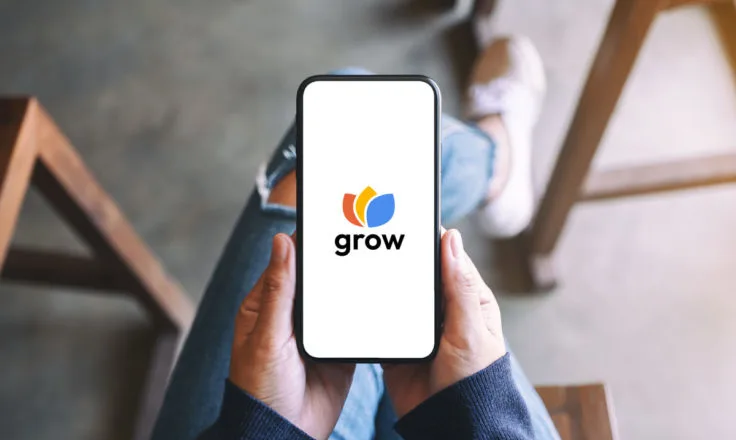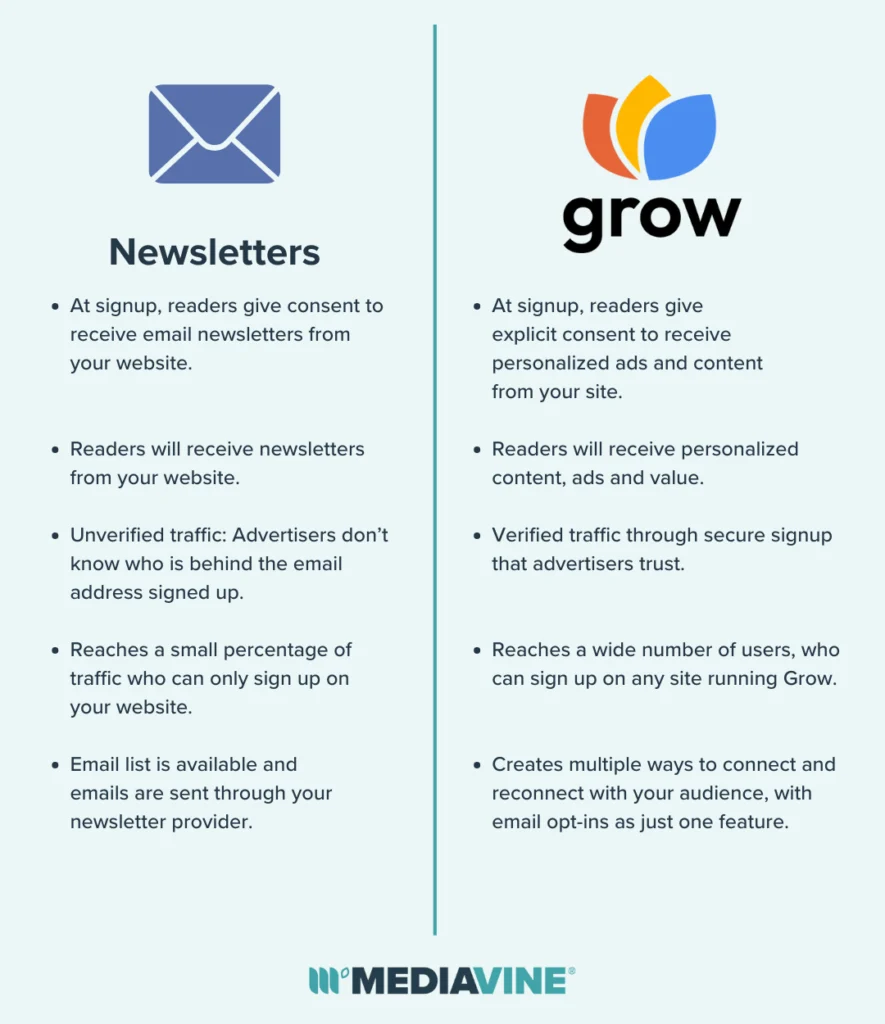Grow is First Party Data. Newsletter Signups Are Not.


Last week, Mediavine announced Grow, our solution for content creators to control first-party data in an ever-changing industry.
We’ll explain each of these points in detail below.
During our September 17 Facebook Live, a few publishers asked why Grow does not make publisher-owned email newsletters the crux of our first-party data solution.
If you want to continue collecting opt-ins and sending out newsletters after running Grow, please do. Our plan is not to fully replicate the functionality of these kinds of products.
Grow is here to help you build first-party data for the future of your business, not simply collect email opt-ins and send newsletters.
These two are fundamentally different things for a few reasons, outlined below:

Ultimately, Grow is a privacy-first solution for first-party data.
As such, it’s critical that we establish the value exchange with the reader, otherwise we’re part of the problem.
Readers sign up for Grow in order to receive personalized content, ads and value from your website. In signing up, they explicitly consented to providing their email address and information for this purpose.
When users sign up for your newsletter, they are not providing that consent. They simply provided an email address in exchange for a newsletter periodically arriving in their inbox.
That was the proposed value exchange they agreed to.
Can you change your newsletter signups or Grow to achieve both of these goals? Yes, but more on that later. There are still issues with using newsletter signups, even if it collects consent for personalized ads.
The methods of identifying users who sign up for a newsletter via a box on your site, or arrive via a newsletter, are what’s called unverified or untrusted authentication in the industry.
You don’t know if the person actually owns that email address, in the case of a reader signing up and even if they came from an inbox, you have no way of knowing if it was from a forwarded email. You didn’t authenticate it was that user’s.
Neither of those sources are verified and authenticated, and as a result, newsletters do not go far enough. They are not first-party data. Grow is about building trust not just with your users, but also advertisers.

Authenticating users via newsletter is not only unverified, we’re likely only talking about a small portion of your traffic, even if your newsletter is how you reach some of your most loyal users.
With Grow, we’re not trying to replace or devalue the newsletter, but solve the issue of user consent for a larger percentage of traffic.
Our initial goals with Grow are lofty, but we’re hoping for 10-20% of your traffic to be verified over time.
That’s enough to make a material difference. The greater percentage of inventory you can authenticate, the greater your revenue impact.

We made the decision to architect Grow so that it’s privacy-first, and therefore a legitimate and lasting solution.
We want audiences to feel safe when they log into Grow on your site and want to stay logged in across the web.
Imagine if you were logged in to Twitter and every account you followed on that platform suddenly had access to your email address, which they could sell or use to bombard you with spam.
The world would quickly lose trust in that system, and for good reason. This is a serious matter, which is why we’ve built Grow the way we have.
Our goal is to build Grow to be a seamless experience across tens of thousands of sites. We want to make it incredibly easy and low friction to have users stay logged in across the web.
If we simply shared that email with every site a user visited, we couldn’t have that same experience if we wanted to keep data security and privacy at the forefront.
In short, yes, there is definitely a world where Grow can help sign up users for your newsletter AND collect first party data.
Unlike the pure newsletter solution, Grow could collect authenticated, verified emails and securely transmit them to you.
In this scenario, Grow would require users to log in and specifically consent to sharing their email with you.
It’s definitely possible, and something we are considering on our roadmap after feedback from our Live.
The truth is, Grow is a beta for this reason. We need to work with you, our publishers, to determine the best experience for your readers.
Grow is designed to be the framework that helps you build first-party data and navigate this changing industry.
It’s important you do so now. First, because the longer you build first-party data, the better off you’ll be when third-party cookies are gone. You’ll also make more money today with Safari and Firefox traffic.
Secondarily, Grow needs your feedback. Any questions or feedback can be sent to grow.me@mediavine.com.
So please, opt in today. It’s right there in your Mediavine Dashboard. Together, let’s build a sustainable solution for a free and open web for a long time to come.
Stay up to date with the latest from Mediavine
In today’s digital landscape, advertisers are becoming increasingly selective about where they place their ads. With the growing importance of brand safety, audience engagement and ROI, the quality of a …
 Eric Hochberger
Eric Hochberger
Since the advent of Trellis, Mediavine’s goal was to provide a WordPress framework to meet the needs and pain points of independent publishers. We’ve had the pleasure of working with …
 Amanda Martin
Amanda Martin
To enhance both the visual appeal and functionality of our publishers’ websites, Mediavine is making essential updates to optimize ad density while meeting industry standards and maintaining revenue performance. We’re …